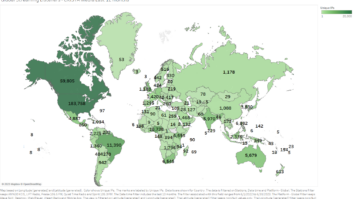As the chairmanship of Kevin Martin — whose dislike for the cable TV industry in general was readily apparent — limped toward its conclusion after the presidential election, a new and exciting way to poke the cable folks in the eye popped up.
As is often the case when the Law of Unintended Consequences is factored in, the proposal, if adopted, could have significant effects which weren’t on the proponents’ agenda — including effects on the radio side of the universe.
The proposal appeared in the form of an application filed by ION Media Networks and a new company, Urban Television LLC, controlled by billionaire and BET founder Robert Johnson.
Ion owns a boatload of television stations (here, “boatload” means 42). It is proposing the “assignment,” or sale, of 42 television licenses to Urban. But ION would not be letting go of its stations in any conventional sense. Rather, ION is proposing to sell, and Urban to buy, “licenses” to operate on a second digital stream of each of ION’s stations.
In other words, ION and Johnson are asking the Federal Communications Commission to treat non-primary digital streams as separate, and separately licensable, authorizations. The proposal contemplates that Urban would hold a separate license for its operations in each of the 42 markets, while ION would continue to hold its own licenses in those same markets.
What a deal for ION: You got it, you sell it, you still got it!
Should radio care?
Of course, the notion that digital streams might be treated as separately licensable “stations” is novel, to say the least.
But don’t try to tell that to ION/Urban. To read their application, this is just a straightforward arrangement that falls comfortably under the commission’s “share time” rule. (That rule may be found in Section 73.1715 of the FCC’s rules — good luck finding any reference in that rule to digital streams, though.)
What does this have to do with radio? Maybe nothing, but maybe a lot.
If the commission embraces the notion that secondary digital streams really do constitute separate licenses that can be separately assigned, one could easily argue that radio stations that have opted to transmit digital streams (i.e., “HD Radio”) should also be permitted to sell those streams as separately licensed stations.
Indeed, if the “share time” rubric is the applicable regulatory touchstone here, it would arguably make more sense to apply that on the radio side, where it has historically come into play, than on the TV side, where there is little if any tradition of “share time” operations.
So what happens if digital radio streams get mystically transmogrified into real, stand-alone stations?
For one, the number of radio stations could theoretically double or triple overnight. This might not have the cataclysmic effect of, say, the injection of nearly 700 new FM allotments through the notorious Docket No. 80-90 a quarter century ago, but you never know.
At a minimum, if the law of supply and demand were to hold true, the overnight doubling/tripling of stations would likely depress each station’s value. And such a rapid increase in the number of stations would logically lead to a similarly rapid increase in competition for audiences and revenues. Are we all ready for that?
New entrant
On the regulatory side, it’s not clear what the FCC might do.
It might seek to adjust its multiple ownership limits to take into account the sudden ballooning of stations.
The ION/Urban deal is being pitched in part as an opportunity to increase “diversity” in the ranks of broadcasters, since Johnson, who controls Urban, happens to be African-American and happens also not to own any full-power TV stations.
Because of those factors, Urban is being cast as a “new entrant” in broadcasting, despite the facts that (a) Johnson is clearly an established media mogul of considerable long standing and (b) ION, which is not a minority entity, owns 49 percent of Urban.
So would the commission adopt rules designed to induce sales to similar “new entrants”? Who knows — but certainly if the FCC is willing to accept Urban as a “new entrant,” it would not be setting the bar particularly high for later claimants to that title.
A staunchly Democratic administration might also see the potential for increasing the availability of certain types of programming which the FCC majority might deem desirable from some general “public interest” perspective.
In the ION applications, Urban is promising to launch a new programming format, including informational and issue-oriented programming targeted to serve the interests of African-American viewers and other “underserved” persons in the 42 markets. Details on exactly what that programming might consist of are sketchy as we write, and Urban’s promise is somewhat porous. (“Urban will retain the flexibility to adapt its format to changing viewer needs and interests and other programming that is available in the marketplace.”)
Look before you bite
Still, the notion of minority-targeted programming in 42 TV markets provides a potentially irresistible sizzle — despite the fact that any FCC decision based on proposed programming would be subject to huge practical problems.
(F’rinstance, how would the commission define “minority-targeted” programming, and how would it define “underserved” persons, and what would happen if the licensee elected to abandon that programming — would the FCC attempt to impose its own programming preferences?)
If the new commission were to focus its attention on regulation of program content, the availability of a huge number of “new” radio stations would provide fertile ground with which to work.
There are almost certainly many more possibilities floating around here, none of them particularly well-defined at this point. But that’s what often happens when radical departures from well-established practices are proposed. And that’s especially what happens when the context in which those departures are proposed is peculiarly narrow.
ION and Urban appear to be trying to force the commission to declare that Urban’s stations — that is, the secondary streams that we would all be calling separately “licensable stations” — are all entitled to must-carry status on cable systems. The must-carry status of secondary DTV streams has been an open question for years, with the broadcast TV folks clamoring for carriage of all their transmitted streams and cable folks clamoring just as loudly to limit the carriage obligations to one cable channel per TV station.
The FCC has not seemed inclined to resolve that question directly in a rulemaking proceeding of general applicability, so ION and Urban have tried to force the issue in the narrow context of their application.
(Since the notion of expanded carriage requirements appealed to ex-Chairman Martin, sources indicate that he may have been instrumental in putting the ION/Urban application on a fast track that saw the release of a request for public comment on the proposal barely a week after the application was filed.)
As an innovative way of getting to their desired goal, there really is no harm in ION/Urban baiting up its hook and casting it into the regulatory waters. But before the FCC bites, the commission — and the industries likely to be affected if the proposal is adopted — should be careful to consider all the possible ramifications.
Harry Cole is a member in the law firm of Fletcher, Heald & Hildreth. Read his blog postings on regulatory developments at www.commlawblog.com. Portions of this article appeared in a blog posted there by Howard Weiss, also of Fletcher Heald.











